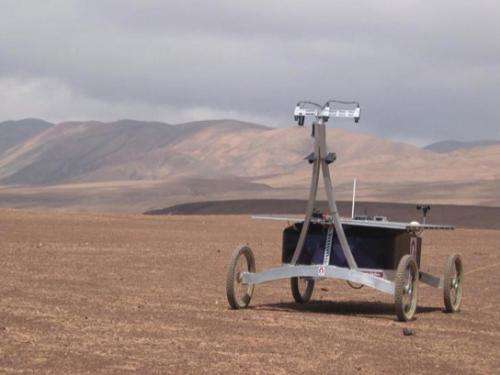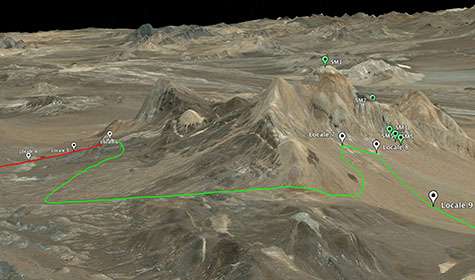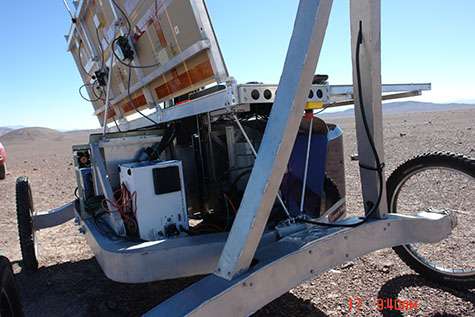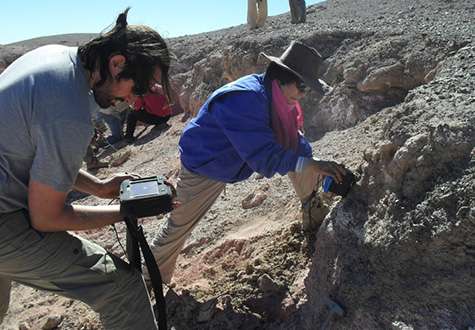Dry run for the 2020 Mars mission

(Phys.org) —A film director looking for a location where a movie about Mars could be shot might consider the Atacama Desert, one of the harshest landscapes the planet has to offer. Due to the accidents of its geography, Atacama is the driest place on Earth. Some scientists believe there was no rain to speak of in part of the Atacama between 1570 and 1971. With little moisture in the air its salt lakes, sand dunes and lava flows broil or freeze and are blasted by ultraviolet radiation.
The conditions make the Atacama a splendid place to test instruments for future Mars missions.
"If you're practicing to find life on Mars, you don't want to go to a lush environment," says Alian Wang, PhD, research professor in the earth and planetary sciences at Washington University in St. Louis and a participant in NASA's ASTEP program to advance the technology and techniques used in planetary exploration.
This month, under the auspices of ASTEP, a Carnegie-Mellon University rover named Zoe set out into the Atacama. It is scheduled to spend the next four weeks traveling between waypoints with interesting geology and analyzing soil samples, both ones from the surface and ones dredged up from deep underground.
Subsurface samples pulled up by a meter-long drill and dumped into sample cups carried by a carousel are to be examined by a laser Raman spectrometer called the Mars Microbeam Raman Spectrometer, or MMRS.
Wang, the principle investigator for the spectrometer, also remotely operates it from her office in St. Louis. Her colleague Jie Wei, PhD, a research scientist in earth and planetary sciences, is traveling with the rover in the Atacama.
Wang says they are hoping Zoe will drive 40 to 50 kilometers and drill 10 to 15 boreholes.

Ready for prime time
The MMRS in its current compact, robust configuration is the culmination of 18 years of work at WUSTL and the Jet Propulsion Laboratory (JPL), led first by former WUSTL professor Larry Haskin, and now by Wang.
The MMRS was originally scheduled to ride on the Mars Exploration Rovers Spirit and Opportunity but after NASA lost two missions on approach to Mars—the Polar Lander and the Climate Orbiter—the MER rovers were downsized and offloaded. The Raman spectrometer, because it was the newest analytical instruments on the rovers, was a casualty of this process.
However, it is now the top candidate among instruments being considered for a 2020 mission to Mars and Wang has just received $3 million from NASA to make sure that it will be mission ready.
What's special about Raman? The spectrometer shines a laser on the sample and measures the energy of the photons the sample scatters back. "Compared to other spectroscopies," Wang says, "Raman spectroscopy returns a very clear spectrum. So if you analyze a mixture (rock or soil) you see peaks for each mineral phase and organic molecule. You don't have to do complicated spectral processing to identify what's in the sample. So compared to other spectroscopies," Wang says, " its very diagnostic. "

Don't fail me now
The journeys in the Atacama are intended is to test the MMRS (and other instruments) until they fail. If a power system is going to fail on Mars, it will probably fail as well in the Atacama. And far better it should fail while still Earth-bound, than when it is 34 million miles away on the Martian surface.
Last year Wang was part of a team that tested instruments in the desert, without the rover, boring holes with hand-held equipment and operating the instruments manually.
Wang was the PI for three of the instruments. "We found some problems we never expected," she says.

"The heat generated by cooling the Raman spectrometer's detector is dissipated by a cooling fan. When we came to the Atacama we were sometimes as high as 4,500 meters (14,800 feet) above sea level. The air is so thin at that altitude, the fan labored to get rid of the heat. That's one lesson we learned."
"Of course it will be different on Mars, "she says, " where the atmosphere is much thinner, but we learned where the instrument is vulnerable. "
On the other hand the laser in the Raman probe has to stay within a certain temperature range to operate properly. "But when we came to Laguna Lejia suddenly we weren't getting a strong enough signal," Wang says. "We started checking and discovered the laser power was only a fifteenth of its normal value. It was so windy and cold the laser couldn't warm up. We had to run it longer before taking measurements to get a good signal. So we learned we had to work out a better temperature control for this laser."
Both discoveries were invaluable since they will allow the team to safeguard against these problems so that they don't occur on Mars

It's alive!
After the Viking landers failed to find evidence of life on Mars in the late 1970s, a group of scientists took duplicate instruments into the Atacama, where they, too, failed to find evidence of life. They did, however, encounter oxidizing soil conditions in the Atacama that destroyed organic molecules, a leading hypothesis for the apparent sterility of the Martian soils.
The Atacama soil tests done last year confirmed the presence of microorganisms in the desert soils. The presence of life in the Atacama does not of course guarantee its presence on Mars. But it does show that if there is subsurface life, the instruments will be able to detect it.
Provided by Washington University in St. Louis





















